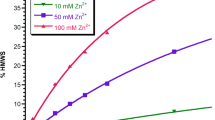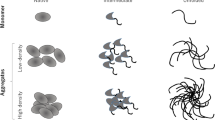ABSTRACT
Purpose
To investigate structure and function of different monoclonal antibody (MAb) dimers.
Methods
MAb dimers were induced by process-related, low pH and UV light stress. Dimers were isolated and purified by chromatography and extensively characterized by biochemical, structural and functional methods.
Results
Highly purified dimer forms were obtained which enabled detailed characterization. Dimers induced by process stress were associated by a single non-covalent interaction site between two Fab domains in a characteristic “bone-like” structure observed in Transmission Electron Microscopy (TEM). These dimers showed reduced potency and antigen binding affinity. Low pH stress generated more stable but also non-covalently associated dimers without chemical alterations in a typical “closed” conformation according to TEM. These dimer species were more compact and more hydrophobic as dimers induced by process stress. They showed bioactivity and antigen binding affinity similar to the native monomer. Light-induced dimers, exhibiting various different conformations, were the most stable dimers with various chemical modifications leading to a broad range in size, charge and hydrophobicity. These dimers fully lost bioactivity and antigen binding affinity.
Conclusion
The use of highly purified MAb dimers and a panel of characterizations methods enabled to obtain a clear picture about molecular architecture and function of dimers.










Similar content being viewed by others
Abbreviations
- AU:
-
absorption units
- AUC:
-
analytical ultracentrifugation
- CDR:
-
complementarity-determining regions
- CE-SDS-NGS:
-
capillary electrophoresis sodium dodecyl sulfate-non gel sieving
- ESI-TOF-MS:
-
electrospray time-of-flight mass spectrometry
- FTIR:
-
Fourier transform infrared
- HBS-EP buffer:
-
hEPES-buffered saline EDTA polysorbate buffer
- HC:
-
heavy chain
- HIC:
-
hydrophobic interaction chromatography
- HUVEC:
-
human umbilical vein endothelial cell
- IEC:
-
ion exchange chromatography
- LC:
-
light chain
- MAb:
-
monoclonal antibody
- SDS:
-
sodium dodecyl sulfate
- SEC-MALLS:
-
size exclusion chromatography with multi angle laser light scattering
- SPR:
-
surface plasmon resonance
- TEM:
-
transmission electron microscopy
REFERENCES
Hermeling S, Crommelin DJA, Schellekens H, Jiskoot W. Structure–immunogenicity relationships of therapeutic proteins. Pharm Res. 2004;21:897–903.
Rosenberg AS. Effects of protein aggregates: an immunologic perspective. AAPS J. 2006;8:501–7.
Kumar S, Singh SK, Wang X, Rup B, Gill D. Coupling of aggregation and immunogenicity in biotherapeutics: T- and B-cell immune epitopes may contain aggregation-prone regions. Pharm Res. 2011;28(5):949–61.
Philo JS. Is any measurement method optimal for all aggregate sizes and types? AAPS J. 2006;8(3):E564–71.
Cao S, Jiao N, Jiang Y, Mire-Sluis A, Narhi L. Sub-visible particle quantitation in protein therapeutics. Pharmeur Bio Sci Notes. 2009;2009(1):73–9.
Singh SK, Afonina N, Awwad M, Bechtold-Peters K, Blue JT, Chou D, et al. An industry perspective on the monitoring of subvisible particles as a quality attribute for protein therapeutics. J Pharm Sci. 2010;99(8):3302–21.
den Engelsman J, Garidel P, Smulders R, Koll H, Smith B, Bassarab S, et al. Strategies for the assessment of protein aggregates in pharmaceutical biotech product development. Pharm Res. 2011;28(4):920–33.
Bond MD, Panek ME, Zhang Z, Wang D, Mehndiratta P, Zhao H, et al. Evaluation of a dual-wavelength size exclusion HPLC method with improved sensitivity to detect protein aggregates and its use to better characterize degradation pathways of an IgG1 monoclonal antibody. J Pharm Sci. 2010;99(6):2582–97.
Zhang A, Singh SK, Shirts MR, Kumar S, Fernandez EJ. Distinct aggregation mechanisms of monoclonal antibody under thermal and freeze-thaw stresses revealed by hydrogen exchange. Pharm Res. 2012;29(1):236–50.
Chi EY, Krishnan S, Randolph TW, Carpenter JF. Physical stability of proteins in aqueous solution: mechanism and driving forces in nonnative protein aggregation. In: Pharmaceutical Research: Springer Netherlands; 2003. p. 1325–1336.
Cromwell M, Hilario E, Jacobson F. Protein aggregation and bioprocessing. AAPS J. 2006;8:E572–9.
Van Buren N, Rehder D, Gadgil H, Matsumura M, Jacob J. Elucidation of two major aggregation pathways in an IgG2 antibody. J Pharm Sci. 2009;98(9):3013–30.
Mahler H-C, Friess W, Grauschopf U, Kiese S. Protein aggregation: pathways, induction factors and analysis. J Pharm Sci. 2009;98(9):2909–34.
Hermeling S, Schellekens H, Maas C, Gebbink MF, Crommelin DJ, Jiskoot W. Antibody response to aggregated human interferon alpha2b in wild-type and transgenic immune tolerant mice depends on type and level of aggregation. J Pharm Sci. 2006;95(5):1084–96.
van Beers M, Sauerborn M, Gilli F, Brinks V, Schellekens H, Jiskoot W. Aggregated Recombinant Human Interferon Beta Induces Antibodies but No Memory in Immune-Tolerant Transgenic Mice. In: Pharmaceutical Research: Springer Netherlands; 2010. p. 1812–1824.
Fradkin AH, Carpenter JF, Randolph TW. Immunogenicity of aggregates of recombinant human growth hormone in mouse models. J Pharm Sci. 2009;98(9):3247–64.
Kiese S, Papppenberger A, Friess W, Mahler H-C. Shaken, not stirred: mechanical stress testing of an IgG1 antibody. J Pharm Sci. 2008;97(10):4347–66.
Mahler H-C, Müller R, Friess W, Delille A, Matheus S. Induction and analysis of aggregates in a liquid IgG1-antibody formulation. Eur J Pharm Biopharm. 2005;59(3):407–17.
Hawe A, Kasper JC, Friess W, Jiskoot W. Structural properties of monoclonal antibody aggregates induced by freeze-thawing and thermal stress. Eur J Pharm Sci. 2009;38(2):79–87.
Joubert MK, Luo Q, Nashed-Samuel Y, Wypych J, Narhi LO. Classification and characterization of therapeutic antibody aggregates. J Biol Chem. 2011;286(28):25118–33.
Remmele RL, Callahan WJ, Krishnan S, Zhou L, Bondarenko PV, Nichols AC, et al. Active dimer of Epratuzumab provides insight into the complex nature of an antibody aggregate. J Pharm Sci. 2006;95(1):126–45.
Ejima D, Tsumoto K, Fukada H, Yumioka R, Nagase K, Arakawa T, et al. Effects of acid exposure on the conformation, stability, and aggregation of monoclonal antibodies. Proteins Struct Funct Bioinforma. 2007;66(4):954–62.
Perico N, Purtell J, Dillon TM, Ricci MS. Conformational implications of an inversed pH-dependent antibody aggregation. J Pharm Sci. 2009;98(9):3031–42.
Qi P, Volkin DB, Zhao H, Nedved ML, Hughes R, Bass R, et al. Characterization of the photodegradation of a human IgG1 monoclonal antibody formulated as a high-concentration liquid dosage form. J Pharm Sci. 2009;98(9):3117–30.
Schuck P. On the analysis of protein self-association by sedimentation velocity analytical ultracentrifugation. Anal Biochem. 2003;320(1):104–24.
Kendall A, McDonald M, Stubbs G. Precise determination of the helical repeat of tobacco mosaic virus. Virology. 2007;369(1):226–7.
Ludtke SJ, Baldwin PR, Chiu W. EMAN: semiautomated software for high-resolution single-particle reconstructions. J Struct Biol. 1999;128(1):82–97.
Byler DM, Susi H. Examination of the secondary structure of proteins by deconvolved FTIR spectra. Biopolymers. 1986;25(3):469–87.
Dong A, Huang P, Caughey W. Protein secondary structures in water from second-derivative amide I infrared spectra. Biochemistry. 1990;29(13):3303–8.
Lau H, Pace D, Yan B, McGrath T, Smallwood S, Patel K, et al. Investigation of degradation processes in IgG1 monoclonal antibodies by limited proteolysis coupled with weak cation-exchange HPLC. J Chromatogr B. 2010;878(11–12):868–76.
Harris LJ, Skaletsky E, McPherson A. Crystallographic structure of an intact IgG1 monoclonal antibody. J Mol Biol. 1998;275(5):861–72.
Roux KH. Immunoglobulin structure and function as revealed by electron microscopy. Int Arch Allergy Immunol. 1999;120:85–99.
Bongini L, Fanelli D, Piazza F, De Los Rios P, Sandin S, Skoglund U. Freezing immunoglobulins to see them move. Proc Natl Acad Sci U S A. 2004;101(17):6466–71.
Roux K, Strelets L, Michaelsen T. Flexibility of human IgG subclasses. J Immunol. 1997;159(7):3372–82.
Demeule B, Palais C, Machaidze G, Gurny R, Arvinte T. New methods allowing the detection of protein aggregates: a case study on trastuzumab. MAbs. 2009;1(2):142–50.
Taschner N, Müller SA, Alumella VR, Goldie KN, Drake AF, Aebi U, et al. Modulation of antigenicity related to changes in antibody flexibility upon lyophilization. J Mol Biol. 2001;310(1):169–79.
Kanai S, Liu J, Patapoff TW, Shire SJ. Reversible self-association of a concentrated monoclonal antibody solution mediated by Fab-Fab interaction that impacts solution viscosity. J Pharm Sci. 2008;97(10):4219–27.
Moore JMR, Patapoff TW, Cromwell MEM. Kinetics and thermodynamics of dimer formation and dissociation for a recombinant humanized monoclonal antibody to vascular endothelial growth factor. Biochemistry. 1999;38(42):13960–7.
Dall’Ozzo S, Tartas S, Paintaud G, Cartron G, Colombat P, Bardos P, et al. Rituximab-dependent cytotoxicity by natural killer cells: influence of FCGR3A polymorphism on the concentration-effect relationship. Cancer Res. 2004;64(13):4664–9.
Ferrara C, Brunker P, Suter T, Moser S, Puntener U, Umana P. Modulation of therapeutic antibody effector functions by glycosylation engineering: influence of Golgi enzyme localization domain and co-expression of heterologous beta1, 4-N-acetylglucosaminyltransferase III and Golgi alpha-mannosidase II. Biotechnol Bioeng. 2006;93(5):851–61.
Lewis JD, Ju RTC, Kim AI, Nail SL. Kinetics of low pH induced aggregation of equine IgG. J Colloid Interface Sci. 1997;196(2):170–6.
Hari SB, Lau H, Razinkov VI, Chen S, Latypov RF. Acid-induced aggregation of human monoclonal IgG1 and IgG2: molecular mechanism and the effect of solution composition. Biochemistry. 2010;49(43):9328–38.
Vermeer AW, Norde W. The thermal stability of immunoglobulin: unfolding and aggregation of a multi-domain protein. Biophys J. 2000;78(1):394–404.
Brummitt RK, Nesta DP, Chang L, Chase SF, Laue TM, Roberts CJ. Nonnative aggregation of an IgG1 antibody in acidic conditions: part 1. Unfolding, colloidal interactions, and formation of high-molecular-weight aggregates. J Pharm Sci. 2011;100(6):2087–103.
Liu H, Gaza-Bulseco G, Faldu D, Chumsae C, Sun J. Heterogeneity of monoclonal antibodies. J Pharm Sci. 2008;97(7):2426–47.
Kerwin BA, Remmele RL. Protect from light: photodegradation and protein biologics. J Pharm Sci. 2007;96(6):1468–79.
Huang L, Lu J, Wroblewski VJ, Beals JM, Riggin RM. In vivo deamidation characterization of monoclonal antibody by LC/MS/MS. Anal Chem. 2005;77(5):1432–9.
ACKNOWLEDGMENTS & DISCLOSURES
We thank Thomas von Hirschheydt, Marc Pompiati, Gordan Graf (all Roche Penzberg) and Marco Sonderegger for their support in isolation of aggregates. We sincerely acknowledge Rita Grübel, Gaby Walch, Jürgen May, Bernd Moritz, Stephen Hyland, Philipp Metzger, Jörg Hoernschemeyer and Eric Kusznir for their contributions to analytical characterizations of the dimers. Thanks to Jochem Alsenz and Michael Hennig for supporting the TEM experiments. We acknowledge Thomas Schreitmueller for sponsoring and supporting the project. This work was in part supported by the Swiss initiative for systems biology (SystemsX.ch).
Author information
Authors and Affiliations
Corresponding author
Electronic supplementary material
Below is the link to the electronic supplementary material.
Supplementary Table I
Summary of the determined chemical modifications in light stress dimers in comparison to the monomer by LC/MS peptide map (DOC 33 kb)
ESM 1
(JPEG 80 kb)
ESM 2
(DOC 3047 kb)
Rights and permissions
About this article
Cite this article
Paul, R., Graff-Meyer, A., Stahlberg, H. et al. Structure and Function of Purified Monoclonal Antibody Dimers Induced by Different Stress Conditions. Pharm Res 29, 2047–2059 (2012). https://doi.org/10.1007/s11095-012-0732-6
Received:
Accepted:
Published:
Issue Date:
DOI: https://doi.org/10.1007/s11095-012-0732-6




